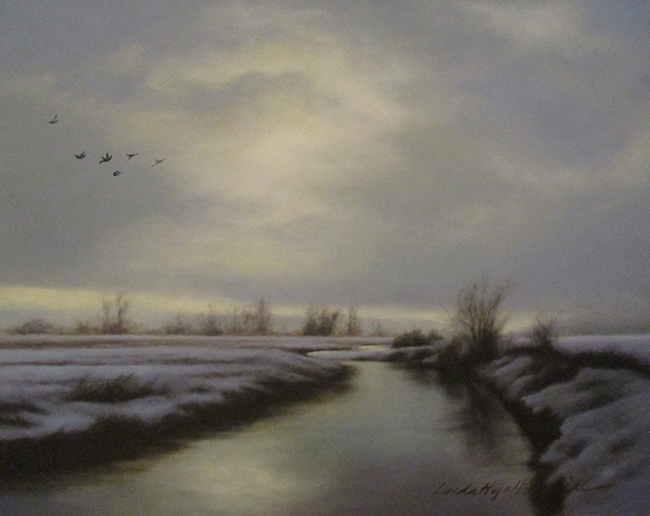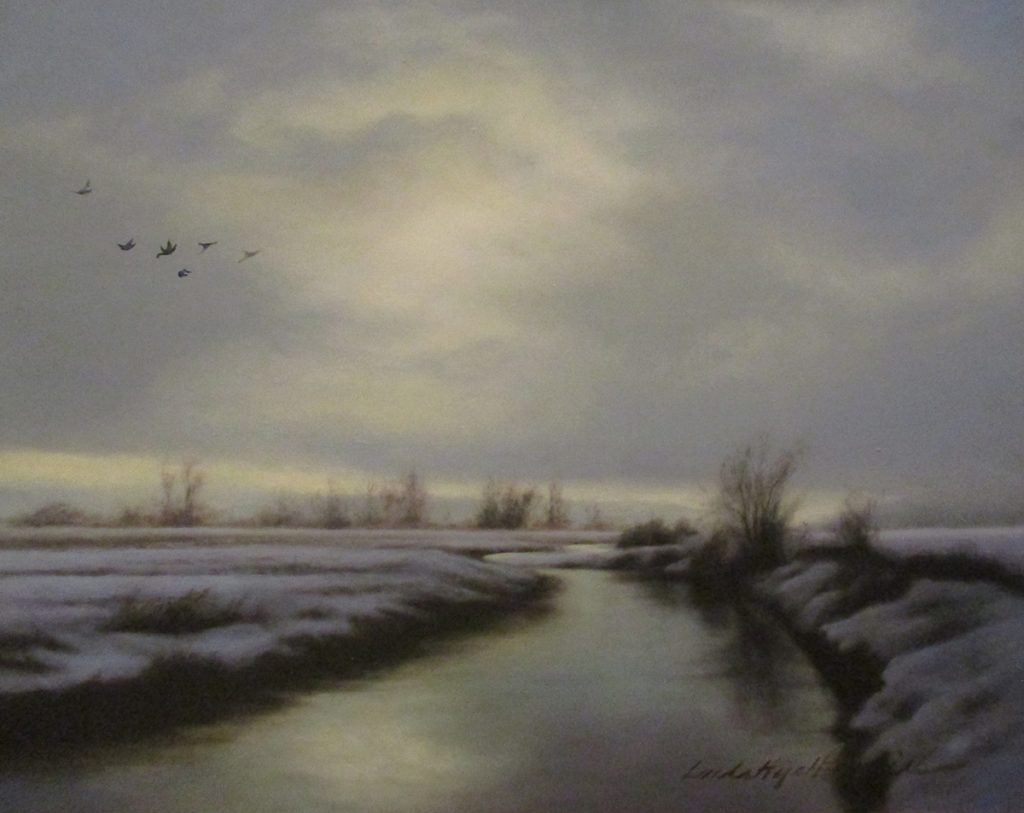Linda Hyatt Cancel was born in 1959 in Moscow, Idaho, and from a young age, she was shaped by the quiet grandeur of the Pacific Northwest. Her earliest memory—watching fireworks explode above the Snake River at fifteen months old—became a kind of artistic imprint. The spectacle of color and light against darkness formed the foundation for her lifelong fascination with atmosphere. Over the years, this early encounter deepened into an exploration of how light interacts with form, how shadows hold memory, and how landscapes carry emotion. Her paintings are more than observations of nature; they are meditations on time, silence, and perception. Through her brushwork, Cancel captures the calm between moments—the faint shimmer before dusk settles, or the slow brightening of morning sky over frozen fields.

“Ascending Through Amethyst” (11″ x 14”)
“Ascending Through Amethyst” feels like a whisper caught in paint. It’s a small piece, but it pulls you inward with its stillness. A narrow stream winds through snow-covered fields under a muted winter sky. The clouds stretch wide and low, filtering light in shades of lavender, cream, and slate gray. A handful of birds rise diagonally across the left side of the canvas, their subtle motion breaking the quiet, their presence hinting at a rhythm beyond the visible world. The title—Ascending Through Amethyst—suggests both movement and transformation, a kind of spiritual passage through color and air.
Cancel’s strength lies in her ability to distill complexity into clarity. The painting carries no overt drama. There’s no human figure, no grand event. Yet the atmosphere is alive with tension—the contrast between the cold earth and the soft, glowing sky, between solitude and migration. Her color palette is restrained but emotive, guided by a painter’s sensitivity to tone rather than spectacle. The faint amethyst hue running through the sky is not a flourish but a feeling, a temperature of the soul rather than a literal color.
The work’s composition leads the eye along the reflective path of the stream, a mirror for the changing sky. This is where Cancel’s control of light becomes almost tactile. The surface of the water holds the last glow of daylight, reflecting the pale warmth that lingers above the horizon. The surrounding land remains in shadow, suggesting the day’s quiet retreat. Through this delicate balance, she captures what many painters of realism attempt but few achieve: the breath of the world as it exhales into stillness.
What makes “Ascending Through Amethyst” resonate is its honesty. There’s no artifice, no attempt to impress. It’s a piece painted by someone who has spent a lifetime watching the land breathe. The influence of the Pacific Northwest is unmistakable—the open skies, the hushed winters, the way light filters through moisture-heavy air. You can almost smell the cold and hear the distant wingbeat of the birds. It’s a sensory experience that bypasses language.
Cancel’s approach to painting recalls the quiet realism of the American Tonalists, who worked to express mood through light rather than detail. But her touch is lighter, less nostalgic. Her brushwork is nearly invisible, allowing atmosphere to take precedence over form. The horizon, soft and unbroken, creates a sense of both distance and enclosure—a reminder that solitude can be both comforting and infinite. In that expanse, viewers are invited to pause and simply look.
There’s also something deeply introspective about her treatment of nature. The landscape becomes a metaphor for internal reflection. The muted purples and silvers speak to a state of awareness between waking and dreaming, where memory and perception blur. The title again guides interpretation—“Ascending Through Amethyst” implies a passage from darkness toward light, an emotional or spiritual lift. The birds, though small, symbolize that movement. They are reminders of motion within stillness, of escape within containment.
Ultimately, this work encapsulates what Linda Hyatt Cancel does best—transforming ordinary landscapes into spaces of quiet revelation. Her painting doesn’t ask for interpretation so much as participation. You stand before it and feel your breath slow. The light changes in subtle ways the longer you look. It’s as if the painting keeps time differently, inviting you to align with its rhythm.
In a world often saturated with noise and color, Cancel’s art stands apart for its restraint. “Ascending Through Amethyst” is not about grandeur but grace. It’s a reminder that the smallest gestures—the tilt of light on snow, the shadow of wings against a pale sky—can hold entire worlds. Through this piece, she affirms that beauty is not something found in motion, but something that rises quietly, almost imperceptibly, through stillness itself.

